Related Research Articles

A baby shower is a party centered on gift-giving to celebrate the delivery or expected birth of a child. It is a rite of passage that celebrates through giving gifts and spending time together.
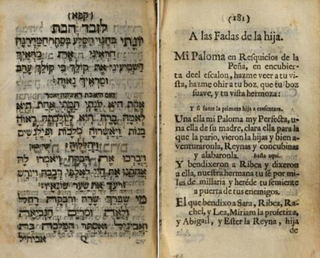
Zeved habat or Simchat Bat is the Jewish naming ceremony for newborn girls. The details of the celebration varies somewhat by Jewish community and will typically feature the recitation of specific biblical verses and a prayer to announce the name of the newborn child.

The first haircut for a human has special significance in certain cultures and religions. It can be considered a rite of passage or a milestone.
Annaprashan/Macha Jankow/Pasni is a Nepali celebration in which a child is fed rice or solid food for the first time. Although centuries old tradition, modern science has established the fact that child's digestive system is capable of processing solid food when they are approximately six months old which is why Pasni is held for when a baby turns six months old but it can vary between daughters and sons.

Vidyarambham, also rendered Akshara Abhyasam, and Mutal Eluttu is a Hindu initiation ceremony that is performed before a child begins their formal education. This ritual is dedicated to the goddess of learning, Saraswati. It is popular in the South Indian states of Karnataka, Kerala, Tamil Nadu, Andhra Pradesh, and Telangana.

Teej, literally meaning the "third" denoting the third day after the new moon when the monsoon begins as per the Hindu calendar, is a combined name for 3 Hindu festivals primarily dedicated to Hindu deities - the mother goddess Parvati and her male consort Shiva, mainly celebrated by married women and unmarried girls mostly in Nepal and North India to wish for the long life of their husband or future husband and to welcome the arrival of monsoon season with the singing, swings, dancing, enjoyment, prayer rituals and often fasting.
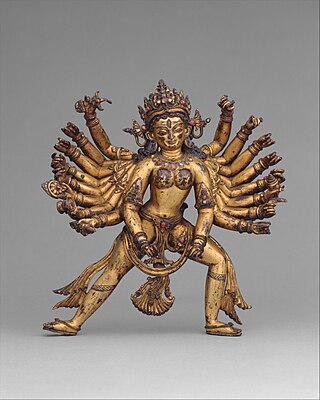
Dashain or Bada'dashain, also referred as Vijaya Dashami in Sanskrit, is a major Hindu religious festival in Nepal and the Indian states of Sikkim, West Bengal, Assam, South India, and Sri Lanka. It is also celebrated by Hindus of Nepal and elsewhere in the world, including among the Lhotshampa of Bhutan and the Burmese Gurkhas of Myanmar. The festival is also referred as Nauratha, derived from the Sanskrit word for the same festival Navaratri which translates to Nine Nights. A version of this festival is celebrated as Navaratri, Navaratri is not exactly the same as Dashain.
Nador (ನಾಡೋರ) or Nadavaru or Nadavar (ನಾಡವರ) is the name of a caste from Karnataka, India. Members of the castle are found primarily in the coastal areas of Uttara Kannada district, formerly known as North Canara, with many members also spread throughout the world. Caste members traditionally speak the Nadavar dialect of Kannada called Nadavar Kannada. They are a prominent agriculture community of the Uttara Kannada district of Karnataka, India.
This article lists the traditional festivals and other cultural events in the Odisha region of India. Odisha celebrates 13 festivals in 12 months as the saying goes Bāra Māsare Tera Parba.

A naming ceremony is a stage at which a person or persons is officially assigned a name. The methods of the practice differ over cultures and religions. The timing at which a name is assigned can vary from some days after birth to several months or many years.
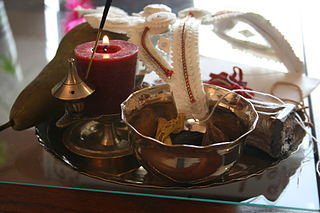
The annaprashana, also known as annaprashana vidhi or annaprashanam, is a Hindu rite of passage (Saṃskāra) that marks an infant's first intake of food other than milk. The term annaprashana means 'eating of cooked rice'. In Vedic Hindu culture, the child cannot eat rice until the annaprashana has occurred. Importance is given to rice because of its symbolism as a life-sustaining food and a sacred food in the form of kheer. The annaprashana remains an important milestone and the ceremony is celebrated in Bangladesh, Nepal and India. It is also known as mukhēbhāt in West Bengal, cōṟūṇŭ in Kerala, and bhāt khulai in Himachal Pradesh. In Nepal, it is also called pasni.

Kartika Purnima, also known as Kartika Pournami, is a Hindu, Sikh, and Jain cultural festival that is celebrated on purnima, the 15th day of the lunar month Kartika. It falls on November or December of the Gregorian calendar and is also known as Tripurari Purnima or Deva-Deepavali, the gods's festival of lights. Karthika Deepam is a related festival that is celebrated in South India and Sri Lanka on a different date. It follows Diwali by about 15 days.

Nuakhai is an agricultural festival mainly observed by people of Western Odisha in India. Nuakhai is observed to welcome the new rice of the season. According to the calendar it is observed on panchami tithi of the lunar fortnight of the month of Bhadrapada or Bhadraba (August–September), the day after the Ganesh Chaturthi festival. This is the most important social festival of Western Odisha and Chhattishgarh also adjoining areas of Simdega in Jharkhand, where the culture of Western Odisha is much predominant.
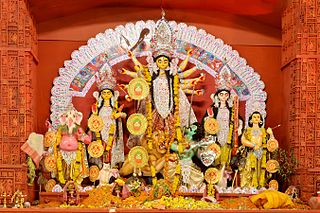
Ayudha Puja is a Hindu observance that falls on the ninth day of the bright half of the moon's cycle of 15 days in the month of September/October, popularly a part of the Navaratri festival. While the Navaratri festival is observed all over the country, the festivity that is widely marked as Ayudha Puja possesses slight variations of veneration and practices across India.
Namakarana is the naming ceremony in Hinduism and a samskara to name a baby.
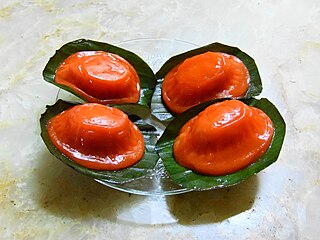
Ang ku kueh, also known as red tortoise cake, is a small round or oval-shaped Chinese sweet dumpling with soft, sticky glutinous rice flour skin wrapped around a sweet central filling. It is molded to resemble a tortoise shell and is presented resting on a square piece of banana leaf. As suggested by its name, red tortoise cakes are traditionally red in color and has a sticky, chewy texture when eaten. Red tortoise cakes are shaped like tortoise shells because the Chinese traditionally believed that eating tortoises would bring longevity to those who are eating it and bring about good fortune and prosperity. Considered to be auspicious items, these sweet pastries are especially prepared during important festivals such as Chinese New Year as offerings to the Chinese deities.
The temple of Shree Balaji Mandir is located at Charkop, Kandivali (West). It is claimed to be the second home place of lord venkateshwara after Tirupati Temple.
The Sangken festival is celebrated in Arunachal Pradesh and parts of Assam, India and in Kachin, Sagaing region of Myanmar as the traditional New Year's Day from 14 to 16 April by the Theravada Buddhist Communities. It coincides with the New Year of many calendars. The Sangken festival is celebrated by the Khamti, Singpho, Khamyang, Tangsa tribes of Arunachal Pradesh, and Tai Phake, Tai Aiton, and Tai Turung communities of Assam. Sangken generally falls in the month of 'Nuean Ha', the fifth month of the year of the Tai lunisolar calendar coinciding with the month of April. It is celebrated in the last days of the old year and the New Year begins on the day just after the end of the festival.

The Twelve Auspicious Rites are a series of worldly rites of passage recognized in traditional Burmese culture, particularly by the Bamar and Rakhine peoples. These are distinct from the Thirty-eight Buddhist Beatitudes described in the Maṅgala Sutta.
References
- 1 2 Gupta, C. Dwarakanath (1999). Socio-cultural History of an Indian Caste. Mittal Publications. p. 181. ISBN 978-81-7099-726-9.